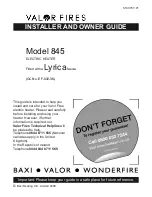
PRESSURE REDUCING VALVE
Proper operation of the dishwater rinse nozzles requires available
water pressure at the nozzle be between 15 and 25 psi when nozzle is
operated. 20 psi is recommended.
If water pressure available to the booster heater inlet is over 20 psi, a
pressure reducing valve should be mounted in the hot water supply line
to the booster heater.
The pressure reducing valve supplied by the manufacturer has a
built-in high pressure by-pass which prevents excessive pressure build-
up as the booster heats up.
TEMPERATURE/PRESSURE GAUGES
Manufacturer recommends a temperature/pressure gauge be installed
in both the inlet and outlet lines to the booster heater. These gauges
provide an instant visual check of the water temperature and pressure
entering the booster heater and leaving the heater. The visual check is
helpful in eliminating unnecessary service calls.
WARNING:
INLET
Connect the booster heater water inlet to a hot water supply line from
the regular water heater. Water temperature from the regular water
heater should be 100°F or 140°F (52°C or 60°C) and should not exceed
160°F (71°C). Minimum temperature differential between inlet and
outlet temperatures should never be less than 20°F (11°C). Provide the
inlet line with a shut-off valve, a full open gate or ball type valve,
together with a pressure reducing valve. Set pressure reducing valve at
20 psi (1.4 kg/cm2) flow pressure.
A 3/4 in. union fitting and a drain valve are needed for easy servicing.
Be sure water flows through the pressure reducing
valve in the proper direction. Check directional
arrow. Valve will reduce pressure only during flow
conditions.
NOTE:
Do not connect the heater directly to a boiler or
furnace coil or any other uncontrolled temperature
source. Such hook-up could cause the thermostat to
lose control and the unit could overheat.
WARNING !!
To avoid development of a leak, do not back up or
loosen any pipe fittings.
CAUTION !!
PLUMBING CONNECTIONS
The valves are set to relieve at 150 psi or when water
temperature reaches 210°F (99°C). Read tag on
valve for additional information.
CAUTION !!
For Installing Temperature and Pressure Relief Valves
in accordance with American National Std.
Z21-22 latest edition. Combination temperature and
pressure relief valves with extension thermostats must
be installed so that the temperature-sensing element is
immersed in the water within the top 6" (152 mm) of
the tank. They must be installed either in the hot outlet
service line or directly in a tank tapping. Combination
temperature and pressure relief valves that do not
have extension elements must be mounted directly in a
tank tapping located within the top 6" (152 mm) of the
tank, and shall be adequately insulated and located so
as to assure isolation from flue gas heat or other
ambient conditions that are not indicative of stored
water temperature. To avoid water damage or
scalding due to valve operation, drain pipe must be
connected to valve outlet and run to a safe place of
disposal. Drain pipe must be as short as possible and
be the same size as the valve discharge connection
throughout its entire length. Drain line must pitch
downward from the valve and terminate at least 6"
(152 mm) above the floor drain where any discharge
will be clearly visible. The drain line shall terminate
plain, not threaded, with a material serviceable for
temperatures up to 250ºF (121ºC) or greater. Excessive
length, over 15' (4.57m), or use of more than two
elbows can cause a restriction and reduce the
discharge capacity of the valve. No shut-off valve shall
be installed between the relief valve and tank, or in the
drain line. Valve lever must be tripped periodically to
insure that waterways are clear. This device is
designated for emergency safety relief and shall not be
used as an operating control. Do not use an antisiphon
or check valve on the incoming water line.
CAUTION !!
2
Summary of Contents for NSF SSB-i & s--01
Page 8: ...8 DIMENSIONS HANGING SUPPORT ...
Page 9: ...9 PLUMBING CONNECTIONS ...
Page 10: ...10 ...
Page 11: ...11 ...
Page 12: ...CP 2M 4 03 Printed in U S A ...






























